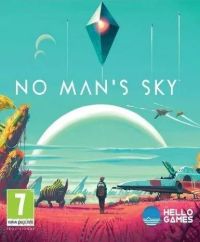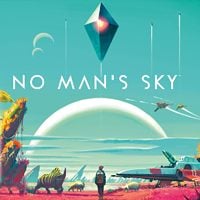No Man's Sky Review – in space no one can hear you yawn
Despite the community’s great expectations, or perhaps exactly because of them, No Man’s Sky painfully disappoints – vast but random, seeking diversity yet repetitive, and sometimes glaringly different from what the trailers promised.
The review is based on the PS4 version. It's also relevant to PC, XONE version(s).
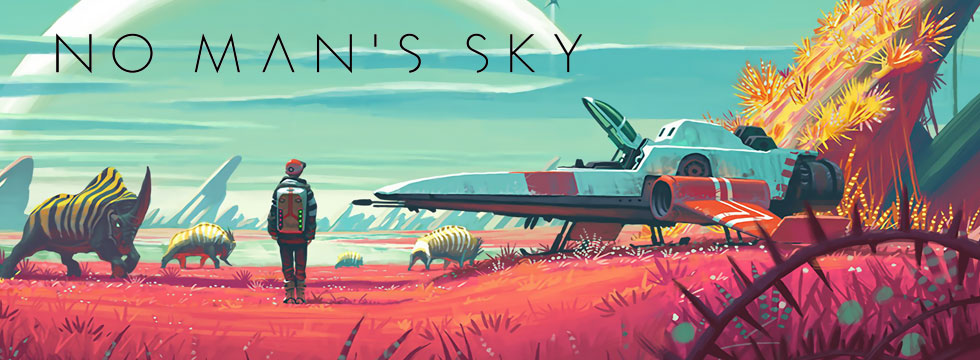
- The first several hours are actually quite fun;
- Climatic soundtrack;
- Some of the planets look outright stunning;
- Amazing technology, delivering a really huge and diversified universe.
- Despite the enormous scope of the universe, there is little to do in it;
- Game based on repetition of the same, uninteresting activities;
- Boring combat;
- Disappointing finale;
- A huge number of bugs, including game-crashing ones;
- Visuals, especially the objects rendered before the player's very eyes.
From its first public presentation No Man's Sky caused quite a stir in the gaming community. A tiny development team led by Sean Murray promised us an unimaginably vast, procedurally generated universe, consisting of trillions of planets featuring diversified atmospheres, weather conditions, amount of resources, and abundance of varied, sometimes spectacular, species of fauna and flora. The players aboard their spacecraft were to have the opportunity to explore and study any celestial body they encounter, duel pirates and civilians alike, engage in trade on space stations, and explore the mysteries of interstellar space – and all of this while employing slightly cartoonish, but nevertheless AAA-class visuals. Such an impressive vision had won the hearts of many a player, making the production from Hello Games studio one of the most anticipated games of the year.
Of course, there were also people for whom that premise seemed too good to be true. The first, very common doubt was whether such an enormous universe, generated using complex mathematical formulas, wouldn't turn out to be painfully repetitive, sentencing the player to performing the same steps over and over again after visiting the first few points of interstellar interest, except with a different land- / starscape in the background. Unfortunately, in the end it turns out that the skeptics were right all along and we learn very soon that the vast expanse provided by the game has very little to offer to those who would like to see something more than a few breathtaking sights – which, by the way, are also a very rare occurrence.
At the rim of the world
No Man's Sky immediately throws the player in at the deep end, choosing a random planet somewhere at the edge of the universe and leaving them there with a damaged spaceship. The corner of the screen displays some hints that explain how to open the equipment panel and how to browse it, as well as what needs fixing and how; where to find the required materials, though, the game doesn’t tell, and we have to tackle this particular quest on our own. I was actually quite lucky, as "my" planet turned out to be quite a pleasant place, boasting a rather bearable average temperature of minus dozen or so degrees Celsius, and the local fauna consisting only of herbivores. Those comfy conditions allowed me to learn the basics of collecting, exploring, and fighting the ever-present Sentinels without unnecessary stress.
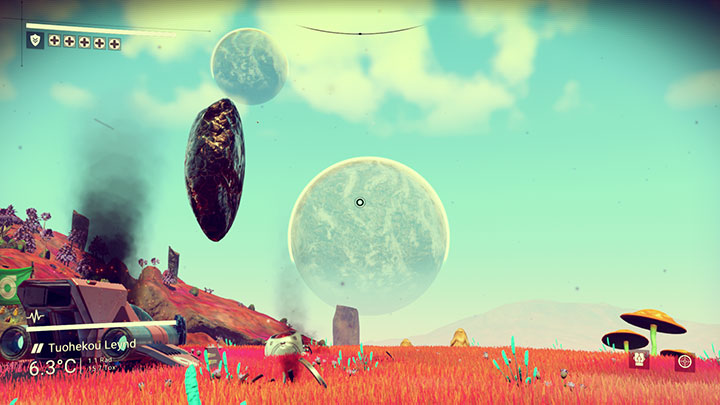
Those initial moments, in my case lasting for about half an hour, were a truly pleasant experience – the planet was huge, and although I gathered the required materials fairly quickly, the urge to look for the strange stones that allowed me to learn alien language, as well as small buildings scattered throughout the planet's surface, discouraged me from immediately leaving the place. Equally successful were the first moments I've spent in space, not as empty as you might have expected – I have barely cleared the atmosphere when I realized that only in my close vicinity there's a trading station, several smaller asteroids, and two more planets waiting to be examined. A crash course on trade with alien life forms, a visit on another world – this time much warmer and much more wet – and I've passed the five hour mark, and No Man's Sky didn't cease to amaze me. My enthusiasm began to melt away, however, with each subsequent planet, as the game had fewer and fewer surprises up its sleeve, and the resources I was selling became the only thing that changed from planet to planet, aside from dominant color palette in the screenshots I took in preparation for this review. It wasn't long before the exploration ceased to excite, no longer offering anything which I had not seen recycled before at least to some degree.
To the center of the universe
The main goal of the game is to reach the center of the universe, although to be honest it may be regarded a secondary, or even tertiary, objective when pitted against the exploration. We can choose one of the three paths to achieve our destination – the path of Atlas, the mysterious diamond-shaped machine that collects all environmental date of the universe, cooperation with a pair of aliens, or going solo. At least that’s what it looks like in theory, because in practice, mixing of the paths is not only possible but even desirable, and the journey is long enough for us to complete all interesting plot lines sooner or later, if only for lack of anything better to do.
And honestly, even this won't be a particularly valuable distraction, because after the somewhat more plot-driven beginning, the game’s "story" begins to chase its tail and has us visit special locations once every few star systems, where, after a short chat, we get a reward for our progress, providing some negligible bonus to the pace of our journey. And so it goes, on and on, until we eventually reach the desired goal, where we are greeted by... a huge disappointment, to say the least. What we find at the center of the universe is by no means a satisfying pay-off for the time we had to spend on the journey. So if anyone was hoping to experience a thrilling story encouraging them to embark on new voyages, then No Man's Sky definitely is not a game for them. The story can be completely ignored, or simply treated as one of the very few distractions available in the game. If, however, we start to feel the growing fatigue, but think that the journey to the center of the universe should be our motivation to continue playing, we can only hurt ourselves, because once we finally achieve our goal, the pain of having wasted way too many hours will be very, very real.
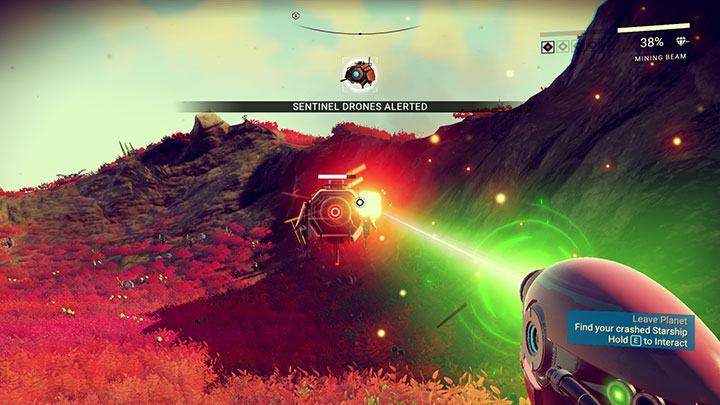
Despite the unlimited freedom and various goals we can pursue, it quickly becomes apparent that only one course of action makes sense in this game: 1) jump to a star system, 2) choose a random planet, 3) do whatever you came here to do, 4) dock at a space station, 5) trade for a while, then repeat steps 2 through 5 or jump to the next system. Rinse and repeat – at least until we can simplify this procedure even further because we no longer have to trade anything, as the only thing we still require is the fuel we have to gather planetside. The only fun activities we can encounter in space are harvesting resources from asteroids (by shooting at them) and engaging in combat.
War among the stars
From time to time we get tracked down by pirates, hungry for the contents of our cargo hold, forcing us to defend our life and property. Nothing stands in our way, however, if we want to enjoy a pirate’s life ourselves and attack any vessel in sight or “respond” to a distress signal sent by large freighter. Unfortunately, such fights are often not very interesting and boil down simply to aiming at enemies and firing away at them with the biggest guns we have. The only more eventful combat scenario is when we need to swiftly open our inventory and recharge our on-board shields, compensating for our worse than average combat performance. Advanced maneuvers, such as barrel rolls, do nothing to help evade incoming attacks, and attempts to escape from the battlefield are rarely successful. The results of a fight are determined only by how much armament we had on our ship – depending on how fast the enemy units blow up under our fire and how much punishment our shields can take, we are able to deal with groups ranging from two to a dozen hostile fighters at a time.
The lack of substance in combat is all the more annoying because No Man's Sky gives off the impression that much more thrilling battles take place right next to us – sometimes entire fleets of colossal battleships warp in or out before our eyes, sometimes the same mighty vessels get swarmed and attacked by organized, squadron-sized groups of fighters. While in theory we can always choose a side and either attack the mobile fortresses or support them in combat, in the end it comes down to the same things we do during our daily pirate skirmishes – shooting at marked targets without even a hint of depth and strategy. And here we are, itching to join one of the fleets, serve as an escort for the duration of their journey through the stars, or form a larger battle formation to attack unsuspecting targets – instead, we can only watch as the AI ??is doing all those interesting things without us.
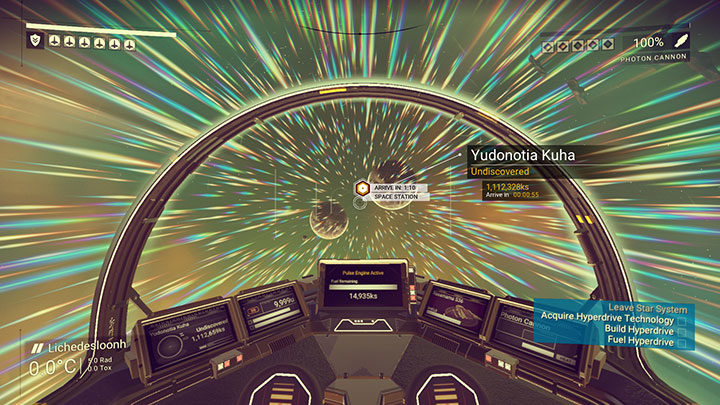
Discover, investigate, collect
Regardless of the type of planet we stumble upon, we can always perform (with one exception) the same set of steps. The said exception being scanning of the local flora and fauna – there are some worlds which are completely barren, where we find nothing except for rocks and some derelict alien structures. Not that we miss something relevant because of this, as scanning is simply taking a closer look at an animal or plant using digital binoculars. The species we thus record can be given a name (just like the planets themselves, landmarks on their surface, and even entire star systems, assuming we are the first ones to see them) and the information can be sent to a central database available to all users. If ever any other player sets foot on this planet and sees the same animal species, he or she will know that it was us who had discovered it. Scanning was the first activity to bore me – neither does it require any special actions besides looking at everything around, nor is it something particularly rewarding. Even predators, which attack us when we get too close, are unable to save this aspect of the game, since they can be easily avoided or simply shot dead.
The main reason for leaving the ship, obligatory regardless of the chosen play style, is gathering resources. Some of them can be found pretty much everywhere, while finding others will depend on luck, but venturing into space without a filled cargo hold is a bad idea. At least during the initial hours, when there actually is a point in earning credits and upgrading the equipment and the ship. After a while, the only really valuable resource will be the elements required for fueling the engines, and they are so abundant that it’s enough to land virtually anywhere, and after a few moments the ship will be refueled. Gathering resources is trivial and boils down to shooting objects built from required elements or interacting with plants. Despite its simplicity and monotony, traveling back and forth for a load of copper or plutonium can be surprisingly fun for some time, especially if there’s a specific goal to it, such as gathering enough nickel to upgrade our stellar drive. However, doing the same thing again and again soon enough becomes an unpleasant duty, hence you will, sooner or later, try to limit such tasks to an absolute minimum. Some diversity is provided by attacking the abovementioned Sentinels, but they, too, cease to pose any threat after some time, and become another mundane obstacle rather than a challenge.
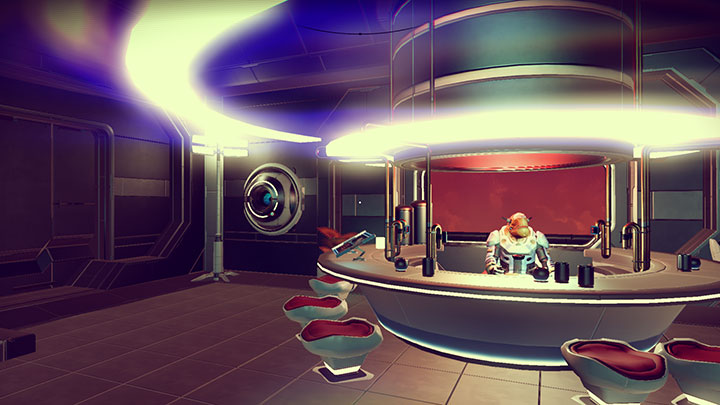
The most interesting part of our interstellar voyages is searching for alien monoliths and buildings – they can be found on practically any celestial body on which the player can land. The monoliths contain knowledge about alien civilizations, which first and foremost allows the player to learn their languages, facilitating communication with the given race. Some more substantial ruins can also be found occasionally – they help to expand the knowledge about the universe of No Man’s Sky. The buildings can either be functional trade posts, military outposts, or derelict buildings of unknown origin. Most of all, though, they are a source of new technologies, and can sometimes provide an opportunity to communicate with aliens. The communication is carried out through a screen with short descriptions combined with the alien’s remarks, which allow the player to establish an attitude towards it. The more words we know, the easier it will be to choose the right answer and gain something valuable. These monuments and facilities, scattered across thousands of planets, are supposed to fuel the players’ desire to venture deeper into the galaxy. Unfortunately, they too are very repetitive, and looking for them quickly becomes as boring as anything else. The game really needs a system of random events that would introduce variety into our space travels.
Are we alone? Definitely
There are many myths surrounding No Man’s Sky’s online features. As the developers themselves disclosed back in 2014, the game was supposed to be an MMO, in which interaction with other players would be limited to a minimum, and the universe too big to allow them to meet frequently. However, soon after the game’s release, players started to report failed attempts to meet despite landing in the same place at the same time. When the problem was more closely looked into, it turned out that the game doesn’t even send information about the player’s location to the server. Then, there’s the matter of the online play icon that has been covered with a sticker on boxes of the game’s collector’s edition – this issue was, however, dismissed by Sony as a manufacturing glitch. I, for one, don’t think that the ability to meet others would be a game-changer, but the fact is that the developer’s conduct can be described as dishonest, since they haven’t uttered a word about suspending the online features of the game. Not to mention that the main architect behind the game, Sean Murray, still tries to convince the players that – contrary to evidence – it is possible to meet others, and the inability to do so was a result of a server malfunction. Unless it’s some awkward PR with a surprise at the end, we have to cross our fingers and hope that the devs are working hard on the online module, and it will become available with one of the future patches.
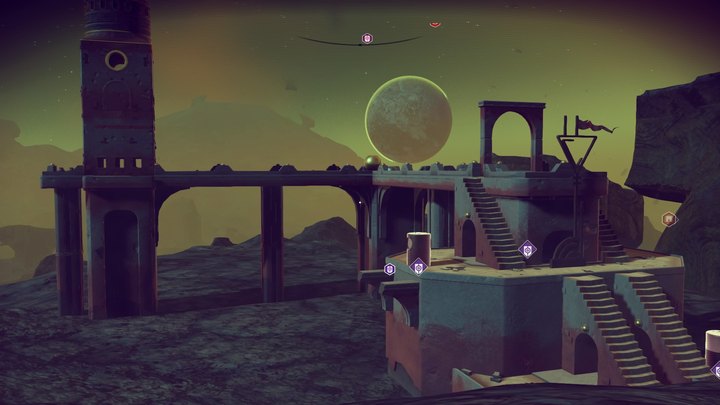
18 446 744 073 709 551 616
The groundbreaking technology developed by Hello Games allowed the studio to generate a universe containing over 18 trillion planets. Still, confirming this number is physically impossible – I can only ascertain that there indeed are lots and lots of planets, and they actually differ from one another; although, as I’ve already established, each of them offers the same kinds of activities, which renders the whole universe flat. Apart from different color palette and variable density and type of flora and fauna, planets can also differ with presence of water (or lack thereof), enormous cave complexes, toxic atmosphere, or extreme temperatures. The list is complemented by fierce storms which force the player to frantically look for shelter. Thanks to the pastel color hues, the variety of planets is further emphasized and the views can be really pleasing, offering some compensation for the lack of interesting content. It would also be nice if, in addition to the animals, some travelers could also be encountered on planets’ surfaces, as we can meet alien races only in outposts and trading posts. After a longer exploration, the lack of bigger cities or at least settlements becomes pretty annoying.
Many Bugs’ Sky
Naturally, generating enormous planets (in case of the biggest ones, walking around them can take a few days), which can only be reached from orbit, had to come at a price. The greatest flaw of No Man’s Sky’s graphics, apart from covering up mediocre details with its cartoonish style, is the conspicuously short drawing distance both in space and on planets. It looks terrible when approaching the planet’s surface from outer space, when the whole landscape – trees, hills, and other elements – grow out from the flat surface in right before our eyes like mushrooms in a time-lapsed clip. The story doesn’t end here – the graphics in general are very inconsistent. Some planets, especially those with more abundant grass and trees (which are pretty rare) look really pretty. However, most of worlds in No Man’s Sky are either arid, or sparsely covered with flora, and those are totally unappealing; when matched against the first presentations of the game from two years ago, the downgrade is beyond dispute. A very atmospheric soundtrack is a definite upside – what’s interesting, it has also been procedurally generated from samples.
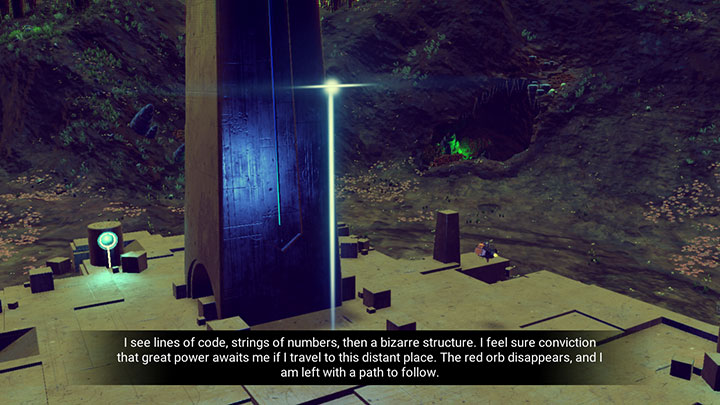
Releasing half-baked games is gradually becoming an ugly standard, with No Man’s Sky currently at the head of this growing, infamous group. Once an unfortunate landing jammed my ship and forced me to walk for an hour in search of a station that would allow me to summon it remotely. On a different occasion, a planet refused to load altogether, and I was unable to land, instead watching an exhibition of graphical artifacts. The game also decided it should prevent me from flying with any speed faster than the minimal, which is rather problematic when you have to travel across a galaxy. And man, can this game freeze. It can run as smooth as silk for seven hours and then die six times during the eighth. And that was on console – the PC port is allegedly even worse.
SECOND OPINION ON NO MAN’S SKY – 5/10
After a couple dozen hours I spent in space, all I can do is agree with the reviewer. No Man’s Sky is a game with great potential that simply hasn’t been used. The game doesn’t have enough content; after two long evenings, you feel you’ve seen everything there is to see. It should rather be treated as a blueprint – in a year or two this game can become a real gem should the developers exhibit enough determination and supply content by means of free DLCs. The landslide of criticism that’s fallen upon Hello Games’ heads is, in my opinion, fully justified. The exploration of hundreds upon hundreds of planets is a magnet for players, but the hope for a long adventure goes absolutely nowhere when we discover that underneath the cloak of unrestrained exploration lies a set of repetitive objectives, a vestigial amount of secrets, buildings that are identical in every system, and the micromanagement mechanics that are as convenient as a towel made of polishing paper, which practically beg to be automated to a greater degree. I am still playing the game, but right now it’s all a far cry from the excitement of a star traveler that I felt at the beginning. The numerous technical issues are also a huge bother on PS4, which still is said to be more stable than the PC version. The game managed to incapacitate my console a couple of times so utterly that a hard reset was the only escape; I cannot count all the times that it had simply crashed without a warning.
UV

A terrible waste of space
While the initial hours spend with No Man’s Sky were truly nice, the magic evaporated pretty quickly, and soon every new trip into space became a dreary experience. The first-impression charm vanished, replaced by a set of activities replayed all over again. After some time, my only motivation to push forward was the remote possibility of finding something new and interesting – these hopes, however, were in vain, for after reaching the center of the universe the only sensation I felt was the regret for the time I had irreversibly lost. Sean Murray’s team wasted the potential of a very powerful technology, or perhaps they didn’t manage to tame it. Yes, they filled their universe with content – but there simply is not enough of it. The terrible technical state the game was released in doesn’t help one bit; neither do the controversies concerning unfulfilled promises about the online features of this game. This is a great technological experiment, but it doesn’t do a good job as a video game.
No Man's Sky
No Man's Sky Review – in space no one can hear you yawn
Despite the community’s great expectations, or perhaps exactly because of them, No Man’s Sky painfully disappoints – vast but random, seeking diversity yet repetitive, and sometimes glaringly different from what the trailers promised.
